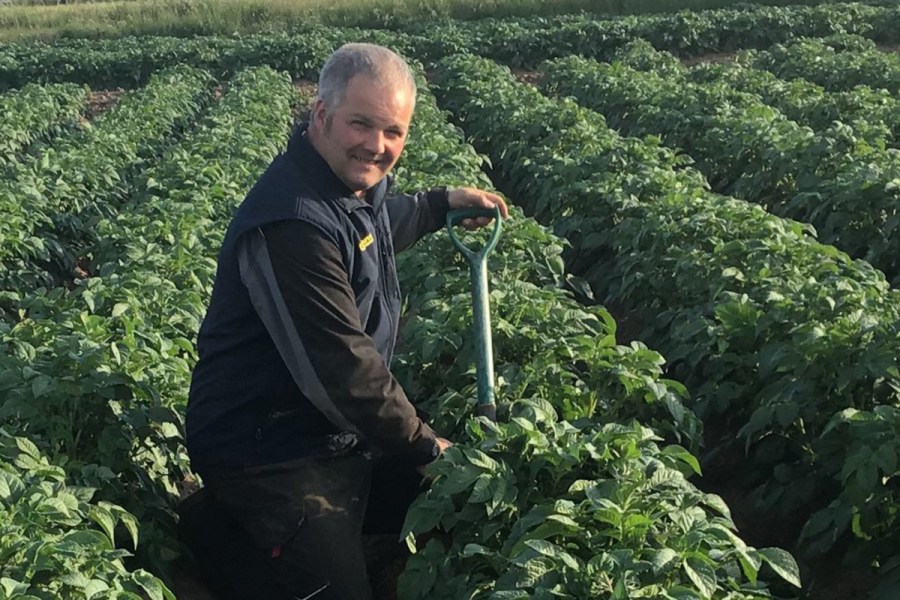By Andrew Wilson
You know how Mother Nature always pays her dues? Up until the end of September, this year’s rainfall totalled 375mm. As I write this in the third week of November, we have received nearly 50% of that figure again since the start of October – 168mm in seven weeks is more than double the weekly average for the year to date. It looks like we’re on track to hit our 10-year average of 760mm (omitting 2012) after all.
Fortunately, we finished what was an uninspiring potato harvest on 18 October in decent conditions. Machinery mostly behaved, we only had a few wet days, and the apprentice earned his stripes for mistake of the season when he didn’t apply the handbrake sufficiently to hold his load of potatoes and finished up with humiliation and a lot of shovelling to cope with! It’s character building, he who never ailed owt, never did owt. Nobody or no machinery was damaged, just pride and a valuable lesson learned (we’ve all done it).
Yields, as predicted last month, were nothing exciting, and wholly dependent on the rainfall received. The worst was on unirrigated light land and just got into double figures per acre. The best had over £800/ha spent on its irrigation and just scraped past the 50t/ha mark. Variety heat tolerance was also a contributing factor, as was growth stage at the point the +30⁰C temperatures hit. Interestingly, our last planted field (13 May) was the best yielding. It was north facing, had two varieties, both chitted, a small amount of muck and no irrigation.
A fault with the DAP applicator facilitated an untreated plot with no applied phosphate. Normally this could be spotted in the crop as if it had a luminous stripe down it, but not this year. The muck had clearly done its thing. The cover crop material mixed into the ridge with the muck visibly contributed to the soil’s water holding capacity, which undoubtedly also helped. A comparable field hamstrung from cover cropping via over winter stubble stewardship didn’t fare so well, and was also harder to harvest, with a lot of hard clod to separate early on.
Storage is a challenge, as expected. Dormancy hasn’t been as bad so far as feared, but is showing in some varieties, particularly those from fields that were under too much stress to apply MH. High temperatures up until very recently haven’t helped in this regard either, pulldown is impossible with double figure temperatures overnight.
We have stuck with ethylene as a sprout suppressant on our chipping crops, and DMN on our crispers. So far, so good with the new kid on the block, but it’s early days yet.
Movement of November contract material is imminent from short-term storage which has kept ok. Our overdraft could certainly do with the relief – it’s a long time since we had two-week payment for our year of outlay, some customers like to keep us waiting for another two months after delivery.
It’s often noted in business seminars that it’s lack of cashflow that kills businesses. This is evident right now, in many sectors. Huge input price rises, and long payment terms squeeze every last penny and that does damage, exacerbated by lack of profit. Pigs and poultry have had a kicking recently, alongside potatoes, and it doesn’t look rosy for the dairy farmers. This invariably has a knock-on effect on demand for our combinable crops, and when put alongside a certain tyrant to the east controlling to a large extent world wheat and fertilizer prices, it takes a certain grit to cling on tight for the bumpy road ahead.
The processing and retail sectors need to wake up to the plight of its raw material suppliers while we still exist, or the consequences to the nation’s food supply will get serious with more empty shelves. In much the same way as we farmers can’t reach for a can of chemical to solve every problem, the retailers can’t simply expect to import produce to replace the gap created by driving British producers out of business.
We all need to make money to survive, adapt and thrive into the future. A sustainable business is a profitable one, and that includes farmers. I fear the ride will get worse before it gets better
One of the hardest things to deal with is the unknown, particularly weather and prices. When to buy and when to sell is much harder than even two years ago. Everyone seems to want more money for less goods, paying quicker, and with much longer lead times. It’s easy to think as a farmer that you’re alone in this, and somehow everyone else is okay. This isn’t the case at all. It was said to me a while back that a bigger farmer often has a bigger overdraft than a small one, and no doubt in some cases that is true. What is also true is that when the chips are down, there is nowhere better than the farming community to find people that will step up and help. Don’t be alone. It will get better. Change sometimes has to happen.
For me, after my potato area increasing almost every year for 20 years since coming home in 1997, I now find myself with less than half the area we grew at the peak in 2017. The reduction has happened in stages, and for sound financial reasons. No regrets yet.
Will @SpudSlingsby become @NoSpudSlingsby? He might if the Solanum tuberosum fortunes don’t improve sharpish! Watch this space.
This article was taken from the latest issue of CPM. For more articles like this, subscribe here.




